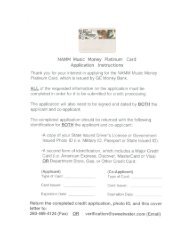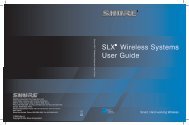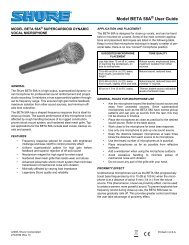Create successful ePaper yourself
Turn your PDF publications into a flip-book with our unique Google optimized e-Paper software.
Performance Functions and Effects<br />
Performance Features<br />
Making detailed settings for<br />
the Solo Synth<br />
D Beam Controller<br />
The D Beam controller can be used simply by waving your<br />
hand over it. It can be used to apply various effects,<br />
depending on the function that is assigned to it. On the GW-8,<br />
the D Beam controller can be used not only to modify the<br />
sounds, but also to control the pitch of a monophonic (solo)<br />
synthesizer sound.<br />
1. Press either D BEAM [SOLO SYNTH], [ASSIGNABLE 1], or<br />
[ASSIGNABLE 2] to turn on the D Beam controller.<br />
1. Press and hold [SOLO SYNTH].<br />
The D BEAM SOLO SYNTH screen will appear.<br />
2. Use [ ] [ ] to select the parameter that you want to<br />
edit.<br />
3. Turn the VALUE dial to set the value.<br />
4. When you’ve finished making settings, press [EXIT].<br />
The Main screen will appear.<br />
These settings are system parameters (p. 46).<br />
Button<br />
[SOLO SYNTH]<br />
[ASSIGNABLE 1]<br />
[ASSIGNABLE 2]<br />
Explanation<br />
Lets you use the D Beam controller as a<br />
monophonic synthesizer.<br />
Operates the function assigned to the D<br />
Beam controller.<br />
Solo Synth Parameters<br />
Parameter Value Explanation<br />
Level & Range<br />
Level 0–127 Sets the volume.<br />
Chorus<br />
Send Level<br />
0–127<br />
Level of the signal sent to<br />
chorus<br />
You can’t use these buttons at the same time.<br />
2. While you play the keyboard to produce sound, place<br />
your hand above the D Beam controller and move it slowly<br />
up and down.<br />
Reverb<br />
Send Level<br />
Range<br />
0–127<br />
2OCT–<br />
8OCT<br />
Level of the signal sent to<br />
reverb<br />
Range in which the pitch of the<br />
solo synth will vary<br />
3. To turn off the D Beam controller, once again press the<br />
button you pressed in step 1 so the indicator goes out.<br />
Osc1<br />
Osc 1<br />
Waveform<br />
SAW, SQR<br />
Waveform<br />
SAW: Sawtooth wave<br />
SQR: Square wave<br />
The usable range of the D Beam controller<br />
The diagram shows the usable range of<br />
the D Beam controller. Waving your<br />
hand outside this range will produce no<br />
effect.<br />
The usable range of the D Beam<br />
controller will become extremely small<br />
when used under strong direct sunlight. Please be aware<br />
of this when using the D Beam controller outside.<br />
Osc 1 Pulse<br />
Width<br />
Osc 1<br />
Coarse<br />
Tune<br />
0–127<br />
-48– +48<br />
Pulse width of the waveform<br />
By cyclically modifying the<br />
pulse width you can create<br />
subtle changes in the tone.<br />
* The Pulse Width is<br />
activated when “SQR” is<br />
selected with OSC1/2<br />
waveform.<br />
Pitch of the Tone’s sound (in<br />
semitones, +/-4 octaves)<br />
The sensitivity of the D Beam controller will change depending<br />
on the amount of light in the vicinity of the unit. If it does not<br />
function as you expect, adjust the D Beam Sens parameter as<br />
appropriate for the brightness of your location. Increase this<br />
value will raise the sensitivity (p. 47).<br />
Osc 1 Fine<br />
Tune<br />
-50– +50<br />
Pitch of the Tone’s sound (in 1-<br />
cent steps)<br />
34
















